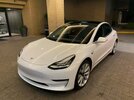Hey all. Just bought a 2020 Model 3 SR+ with 13,000 miles on it. I've had it two weeks today and had some questions about my efficiency and battery health.
I understand, of course, that I will not be getting the range advertised as I will not be driving in the very specific conditions that EPA tests them under. I also recognize my own ignorance as this is my first EV. I'm just trying to step up to the learning curve quickly. If there is something to be concerned about, I want to have it addressed since I'm still under the 50,000 mile bumper to bumper warranty.
Now a disclaimer. I had been going to a supercharger to get charged while I waited to get my NEMA 14-50 installed for my UMC. That was taken care of this week and I have charged my M3 at home just two nights as of this post. I've seen it suggested that a more regular slow charge can help with overall efficiency, but again, I'm brand new to all this.
After two weeks, here's what I see, according to Tessie:
•Battery Health - 89.2% / Degradation 10.8%
•Capacity 45.8 kWh
Based specifically on my last two weeks of driving:
•Distance - 611 miles
•Energy used - 164.9 kWh
•Efficiency - 78% 270 Wh/mi
So I understand some of this. Enough to suspect that maybe I just accelerate too fast? I drive for DoorDash, so maybe that has something to do with.
I would appreciate any feedback
I understand, of course, that I will not be getting the range advertised as I will not be driving in the very specific conditions that EPA tests them under. I also recognize my own ignorance as this is my first EV. I'm just trying to step up to the learning curve quickly. If there is something to be concerned about, I want to have it addressed since I'm still under the 50,000 mile bumper to bumper warranty.
Now a disclaimer. I had been going to a supercharger to get charged while I waited to get my NEMA 14-50 installed for my UMC. That was taken care of this week and I have charged my M3 at home just two nights as of this post. I've seen it suggested that a more regular slow charge can help with overall efficiency, but again, I'm brand new to all this.
After two weeks, here's what I see, according to Tessie:
•Battery Health - 89.2% / Degradation 10.8%
•Capacity 45.8 kWh
Based specifically on my last two weeks of driving:
•Distance - 611 miles
•Energy used - 164.9 kWh
•Efficiency - 78% 270 Wh/mi
So I understand some of this. Enough to suspect that maybe I just accelerate too fast? I drive for DoorDash, so maybe that has something to do with.
I would appreciate any feedback



